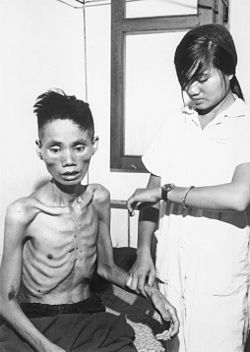再餵食症候群
外觀
| 再餵食症候群 | |
|---|---|
 | |
| 1966年在越南南方民族解放陣線的戰俘營中饑餓一個月。 | |
| 風險因素 | |
| 分類和外部資源 | |
| 醫學專科 | 消化科 |
| DiseasesDB | 11205 |
再餵食症候群(Refeeding syndrome)是長期飢餓後,再開始補充營養後可能出現的一種病症[2]。不只發生在口服補充,也可能發生在完全腸道外營養治療後[2]。可能會造成低磷酸鹽、低鎂、低鉀和低硫胺素[2]。可能會造成虛弱、呼吸減弱、協調性差、精神錯亂、癲癇和心律不整[2]。
風險因子包括飲食失調、酗酒、手術後、慢性營養不良、減肥手術和炎症性腸病[2]。可能的機轉包括血糖升高後導致胰島素濃度上升,進而促使細胞吸收鉀和磷酸鹽[2]。依據是血中的磷酸鹽、鉀或鎂的濃度下降來診斷[2]。並依它們減少的呈度決定嚴重度,減少 10% 至 20%為輕度,減少 20% 至 30%為中度,減少 30% 以上則為重度[2]。
治療是緩慢逐漸恢復熱量的攝取[2]。在最初的 24 小時內,建議補充的熱量為 10 至 20 kcal/kg,或不超過人體能量需求的一半[3] [2]。應儘早補充硫胺[2]。通常還建議補充鉀、磷酸鹽、鈣和鎂[3]。一開始應每 12 小時測量一次電解質[2]。
再餵食症候群的發生率尚不清楚[2]。一項研究發現,住院患者中,盛行率約為 0.5% 至 18%[2]。有關再餵食症候群的現代描述可以追溯到第二次世界大戰[2]。不過,歷史上曾多次出現饑荒後人們再進食後死亡的記錄[4] [5]。
參見
[編輯]參考文獻
[編輯]- ^ Evidence — Nutrition support for adults: oral nutrition support, enteral tube feeding and parenteral nutrition — Guidance. National Institute for Health and Care Excellence (NICE). 22 February 2006 [2025-01-26]. (原始內容存檔於2019-02-09). 已忽略未知參數
|orig-date=(幫助) Web page with link to full guideline CG32. - ^ 2.00 2.01 2.02 2.03 2.04 2.05 2.06 2.07 2.08 2.09 2.10 2.11 2.12 2.13 2.14 Persaud-Sharma, D; Saha, S; Trippensee, AW. Refeeding Syndrome. StatPearls. January 2021. PMID 33232094.
- ^ 3.0 3.1 Mehanna HM, Moledina J, Travis J. Refeeding syndrome: what it is, and how to prevent and treat it. BMJ. June 2008, 336 (7659): 1495–8 [2009-02-24]. PMC 2440847
 . PMID 18583681. doi:10.1136/bmj.a301. (原始內容存檔於2021-08-29). 網際網路檔案館的存檔,存檔日期2021-08-29.
. PMID 18583681. doi:10.1136/bmj.a301. (原始內容存檔於2021-08-29). 網際網路檔案館的存檔,存檔日期2021-08-29.
- ^ Refeeding Syndrome in Historical Perspective: Its First Description by Rodulfus Glaber (1033) (PDF). AJBSR. January 7 2021 [7 March 2021]. doi:10.34297/AJBSR.2021.11.001644. (原始內容存檔 (PDF)於16 January 2021). 網際網路檔案館的存檔,存檔日期16 January 2021.
- ^ De Santo, Natale G; Bisaccia, Carmela; Phillips, Malcolm E; De Santo, Luca S. Refeeding syndrome as described in 1507 by Antonio Benivieni in Florence. Nephrology Dialysis Transplantation. 11 December 2020. PMID 33313827. doi:10.1093/ndt/gfaa295.
書目
[編輯]- Shils, M.E., Shike, M., Ross, A.C., Caballero, B. & Cousins, R.J. (2006). Modern nutrition in health and disease, 10th ed. Lippincott, Williams & Wilkins. Baltimore, MD.
- Mahan, L.K. & Escott-Stump, S.E. (2004) Krause's Food, Nutrition, & Diet Therapy, 11th ed. Saunders, Philadelphia, PA.
- Hearing S. Refeeding syndrome: Is underdiagnosed and undertreated, but treatable. BMJ. 2004, 328 (7445): 908–9. PMC 390152
 . PMID 15087326. doi:10.1136/bmj.328.7445.908.
. PMID 15087326. doi:10.1136/bmj.328.7445.908. - Crook M, Hally V, Panteli J. The importance of the refeeding syndrome. Nutrition. 2001, 17 (7–8): 632–7. PMID 11448586. doi:10.1016/S0899-9007(01)00542-1.
- Lauts N. Management of the patient with refeeding syndrome. J Infus Nurs. 2005, 28 (5): 337–42. PMID 16205500. S2CID 39877542. doi:10.1097/00129804-200509000-00007.
- Kraft M, Btaiche I, Sacks G. Review of the refeeding syndrome (PDF). Nutr Clin Pract. 2005, 20 (6): 625–33. PMID 16306300. doi:10.1177/0115426505020006625. hdl:2027.42/142310
 .
. - Evidence — Nutrition support for adults: oral nutrition support, enteral tube feeding and parenteral nutrition — Guidance. National Institute for Health and Care Excellence (NICE). 22 February 2006 [2025-01-26]. (原始內容存檔於2019-02-09). 已忽略未知參數
|orig-date=(幫助) Web page with link to full guideline CG32. - Mehanna, H. M., Moledina, J., & Travis, J. (2008). Refeeding syndrome: what it is, and how to prevent and treat it. BMJ (Clinical research ed.), 336(7659), 1495–1498. https://doi.org/10.1136/bmj.a301
